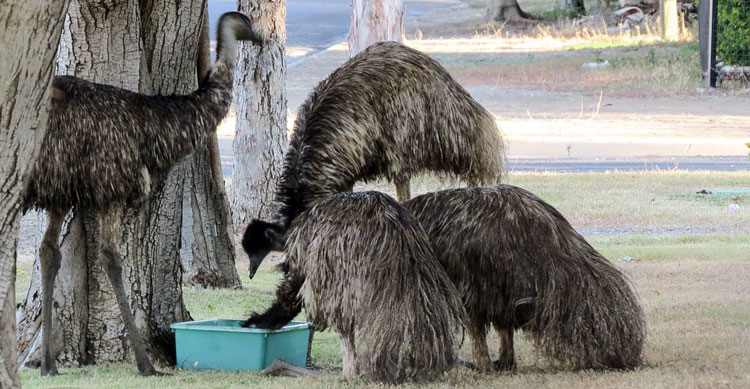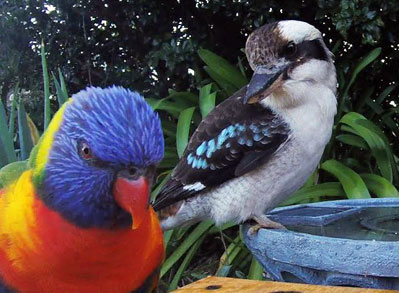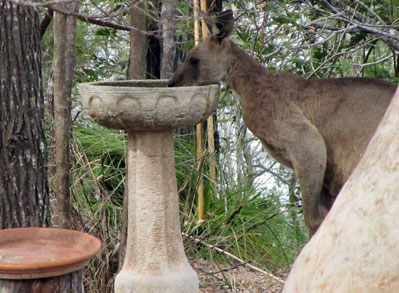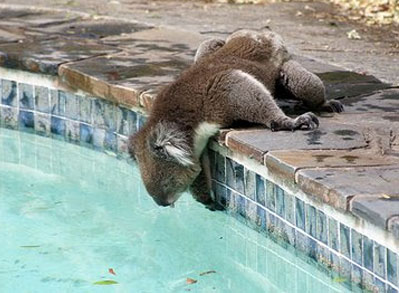Feeding Wildlife during drought and bushfires
Fire is a part of many Australian ecosystems. Many of our plants, trees, and forests have adapted to deal with fire and many of our native animals are capable of escaping slow moving fires, and their populations bounce back.
In recent times, however, extreme drought, and higher than normal temperatures have resulted in bushfires that are more intense, more widespread and the bushfire season is longer. These changes have severe consequences for our wildlife, both now and in the long term.
In a practical sense, how can we help?
Rest assured, there is a lot you can do to help even in a small suburban yard. Here is some advice on what to do, and what to avoid when looking after our wildlife. Without proper guidance and care, feeding wildlife can do more harm than good, so please take the advice below seriously.

There are two major problems facing our wildlife;
- Animals that have survived a fire cannot find enough food and are vulnerable to predators because of the lack of shelter. Many of them are wounded or orphaned adding to their vulnerability.
- The remaining wildlife numbers and habitat is critically low. If the fire is fierce and widespread, especially in patchy habitat, bush fires can eliminate local populations entirely, either by mortality during the fire or by destroying the resources they need to survive in the long term, including opportunities to repopulate.
Under normal conditions, the rule of thumb is that you don’t feed wildlife. Feeding can cause problems including; familiarity which is contrary to natural wariness and independence; disruption of natural hunting or foraging behaviour; spread of disease when too many animals are congregating in one place, causing an increase in one or more species to the detriment of others; and inappropriate food which can have many negative effects on wildlife. So, while feeding wildlife would not normally be recommended, the current situation calls for different action. Extreme drought and catastrophic fires are putting unusually high pressures on our wildlife.


The Do’s:
- It is always best to contact your local wildlife rescue group for advice. Work in a team if you can, and take a coordinated approach.
- Ensure you are mimicking their natural diet as much as possible (details below).
- All animals great and small need water. If there are no natural water sources you may need to set up drinking troughs. Use shallow bowls for birds, insects and reptiles. Place rocks in the bowls so small reptiles and insects can get out. For larger animals do not use buckets as they easily tip; solid dog bowls or pot plant bases are ideal. Please check regularly to ensure there is plenty of CLEAN water in the containers—ideally rain or spring water. Put water bowls in the shade at different levels, on and off the ground, so that different species can benefit. See our article on water for wildlife.
- Scatter food amongst leaf litter or under logs or dense plants for ground-foraging forest species to avoid attracting predator species like currawongs. Currawongs are notorious for preying on the nestlings of other species, and are powerful flyers so can easily seek food elsewhere. For foliage-gleaning birds and possums, food can be placed higher in trees or elevated feeders.
- Keep cats indoors/contained during this time when more birds are coming into the suburbs to escape fires. Going forward, if you have cats that normally free range outdoors, it might be worth thinking about a long term containment system. It really will make a big difference for the survival of our wildlife who are now more vulnerable than ever.
- Cover your pool if there's a chance of wildlife falling in and drowing. Stressed and distressed animals that are fleeing fires, or pushed into residential areas due to the drought are looking for water. Backyard pools can pose a significant threat from drowning. Also see this article on different types of floatation devices that can be used to help wildlife escape pools.


The Don’ts:
- Be careful not to place water or food close to the roadside. Drawing wildlife into areas where they need to cross roads will cause an increase in fatalities.
- Do not place food on the ground for possums or birds (except scattered loosely amongst leaf litter as described for ground-foraging birds, lizards and small mammals). This will make them vulnerable to predators.
- Do not feed carrots: some government departments use carrots for baiting so we don’t want our wildlife getting accustomed to carrots as food.
- Do not feed parrots sunflower seed. It is too high in oil and unhealthy in large quantities.
- If you have pets, think carefully about if and where you should put food and water out. Cats will quickly learn where birds and other small animals are congregating.


Here are some of the animals that especially need a helping hand
Dunnarts, antechinus, bandicoots and native rodents:
Dunnarts and antechinus are small carnivorous/insectivorous marsupials – small cousins of Quolls and Tasmanian Devils. They look like mice but they have sharp carnivore style teeth and eat mice, along with small lizards and insects, worms etc. Bandicoots and native rodents are a bit more mobile but still vulnerable.
Try good quality dry dog food or dried mealworms scattered thinly amongst leaf litter. A tiny amount of peanut butter could help attract them by smell, but not to be used long term. Be careful not to attract their predators (dingos, foxes, dogs, cats) by supplying any large or conspicuous pieces: it is better to place it under logs where nothing smaller than a bandicoot is likely to reach. Water is essential to counteract the dryness of the food. If shelter is severely compromised, local logs could also be provided.
Lizards:
Skinks are the most numerous lizards in Australia. They are small with weak legs and can’t travel far to find food after a fire. Even the larger goannas have their limits on how far they can travel to find food. You can help lizards in the same manner as for Antechinus.


Small insectivorous birds:
Small birds such as Scrub Wrens and Log-runners find it hard to find food after fires for a number of reasons. While they are more mobile than lizards, they are still limited as they can’t simply move to other forests because they face competition from other birds in the area. Help can be provided similar to the Antechinus and Lizards, and with insectivore mixes like those provided by Wombaroo – see Wombaroo Stockists here. In the longer term you can grow plants that attract insects that will not only be beneficial for your garden, but attract and feed insectivorous birds as well. A great seed mix that we've tried is Good Bug Mix which you can buy online from Green Harvest.
GREEN HARVEST HAVE JUST GIVEN US A PROMO CODE FOR GOOD BUG MIX More than 50% off!!
Use SG113 at checkout in the ''Item of Promotional Code'' Instead of $6.95 the charge will be $3.00 each. Thankyou Green Harvest!!


Large insectivorous birds: Magpies, Pee Wees etc
Never feed bread, cheese or fatty mince (kangaroo mince is ok, very lean beef mince if nothing else available). These foods are high in fat and starch - insects are not. Insects also provide high levels of nutrients that are low in meat. Feeding the wrong food to birds can also have detrimental effects on their offspring. For example, feeding Magpies mince can cause Brittle bone syndrome in their young because of lack of calcium. Thin strips of raw kangaroo meat or kangaroo mince, or small amounts of kangaroo based dried dog food for small dogs is ok. As with your animals check that the fat and sodium content is not high. Water is essential along with dry dog food or the birds will quickly become dehydrated. Again – the insectivore mix available from Wombaroo is one of the best options. see Wombaroo Stockists here.
Seed/grain eating birds: Parrots, Cockatoos, Galahs, budgies, Finches etc
Feed good quality budgie seed, or small parrot mix with small seeds. All seed-eating birds can cope with small seeds. Do not feed black or grey sunflower seed it is high in oils and is not good for parrots. Try to elevate the feed off the ground in a feeder, on an outdoor table, or in the trees. At ground level birds can become easy prey.
Consider whether seed may germinate in places where it would be unwelcome amongst native vegetation.


Hollow-nesters:
Possums, including Gliders, parrots, native bees and other species may lose trees with hollows. A few artificial nest-boxes may help these through the tough times, especially in breeding season.
Food for Possums may need to be replenished daily with starchy veg like sweet potato, pumpkin as well as corn, apples, pears, oranges and watermelon (good sources of fluids); and herbs such as basil, parsley and coriander. Try not to make fruit offerings obvious to currawongs (providing after sunset would help).
Macropods – eg. Kangaroos, Wallabies, Wallaroos, tree-kangaroos, pademelons
Many macropods will manage to escape fire, but significantly reduced habitat and drought will mean they need support with food and water. There is a wide variety of commercially available ‘roo pellets’ that have been specifically designed for macropods. Some wildlife carers have reported that roo pellets can be unrecognisable to macropods, however, and foods tailored for horses and ponies can be a good option if pellets are unavailable or not being eaten. Lucerne chaff, and horse pellets which include molasses are well received and more palatable - eg Esyresult and Old Timers horse food are good options for the short term, encouraging roo pellets for the longer term. Meadow hay can also be a good option for macropods.
Don't feed macropods ''brassica'' vegetables (kale, cabbage, broccoli, cauliflower, brussels sprouts, bok choy). Hind gut fermenters do not tolerate them and these foods can make them quite unwell.
Macropods normally feed early in the morning and in the evening. Food is best placed in the late afternoon, thinly scattered amongst leaf litter if possible.
Be aware that feeding can bring out aggressive behaviour in macropods. They can become conditioned to expect food and will approach humans so never hand feed or get too close.
Wombats
Wombats will have been safe in their burrows but upon emerging will have no food. The list of foods for kangaroos can also be given to wombats.
-perfect-pets-feeding-wildlife-blog.jpg)



Wildlife need plants and trees
Keepiing a garden going to help support wildlife and insects isn't easy during drought. The last thing we want is to lose existing trees and plants that can provide refuge for wildlife. Here's some ways that you can help your thirsty plants:
- Keep a tub in your kitchen sink and collect all rinsing water. It's not hard to fill 4-6 tubs of water a day that can go straight onto your garden.
- Direct your grey water (shower and washing machine water) onto the garden. You can either run a hose from your washing machine or ask a plumber to help with this easy redirection.
You can also plant for beneficial insects and bees. Green Harvest have an easy to sow and grow seed mix that you can buy online - Good Bug Mix. Planting particular flowers and herbs known as insectary plants has been proven to improve the natural balance and reduce pest outbreaks. It also attracts insectivorous birds like Willi-wagtails, Robins and Fantails.
GREEN HARVEST HAVE JUST GIVEN US A PROMO CODE FOR GOOD BUG MIX More than 50% off!!
Use SG113 at checkout in the ''Item of Promotional Code'' Instead of $6.95 the charge will be $3.00 each. Thankyou Green Harvest!!
Native bees like:
- Cut-leaf daisy Brachysomes
- Lavender
- Flowering gum
- Pincushion Hakea Hakea laurina
- Tea tree Leptospermum
- Purple Coral Pea Hardenbergia violacea
Other common flowers that Bees Love:
- Alyssum
- Agastache (anise hyssop)
- Asclepias (butterfly weed)
- Aster
- Echinacea (coneflower)
- Geranium (cranesbill)
- Monarda (bee balm)
- Papaver (poppies)
- Rudbeckia (black-eyed Susan)
- Trifolium (clover)
- Grevillia Pink Surprise.
Please share your experience:
Not much is known about how wildlife affected by severe fires cope afterwards. So please take some notes on what seems to work, which foods are being eaten, and not eaten, and by which animal species. You can share that information by commenting on this blog post, or emailing us at [email protected]. If you want to go the extra mile, the setting of camera traps triggered by wildlife can be useful to monitor just which animals are feeding and when.
In the long term it’s important to understand that Australian Native Wildlife specific nutritional requirements. Wombaroo have specialised products suitable for different types of Native Wildlife – see Wombaroo products and information for Wildlife and Stockists here.
This article has been put together with the advice and assistance of :
Lee Newton - Volunteer wildlife carer for 25+ years, Trainer for RSPCA Wildlife ACT 18 years, Zoo keeper and food preparation keeper 8 years – National Zoo and Aquarium.
Debby Cox: Debby who has a master’s in Environmental Science with a focus on wildlife management, started out as a veterinary nurse, working in rural NSW and for the RSPCA at Yagoona in Sydney. She later changed career paths to become a zookeeper at Taronga zoo, working primarily with primates and African mammals. In 1993 Debby ventured onto the continent of Africa, where she spent the next 25 years establishing several wildlife sanctuaries, and conservation and animal welfare programmes for African wildlife in multiple countries. In 2016, Debby returned to Australia and became property manager with the Indigenous Land Corporation for Fish River Station, located in the Northern Territory. This property is being managed as a conservation area by Indigenous rangers.
Dr Ronda Green, Phd – Ronda holds a PhD in zoology and has conducted much ecological and behavioural research over the years, especially seed dispersal by fruit-eating animals and the effects of habitat alteration on wildlife, and is the author or co-author of a number of publications. Ronda is currently adjunct research fellow at the Environment Futures Research Institute, Griffith University, chair of Wildlife Tourism Australia and Scenic Rim Wildlife and has conducted many workshops, excursions, displays and other events on behalf of both. Ronda has also consulted with Wildcare and the Currumbin Wildlife Hospital on appropriate foods for wildlife. The Scenic Rim branch of Wildlife Preservation Society of Qld is also holding some donations for wildlife food. Anyone in the SEQ region wanting to feed wildlife responsibly and finding it difficult to afford it can contact Ronda on [email protected]
Photos - many thanks to Jordan Kirk - Xinger Xanger, Grainne Cleary - Bathing Birds, Lee Newton, and Granchau
Products Just Donated for Wildlife Rescue - Thankyou Petbarn Foundation!
Five pallets of bird seed and other essential products and accessories have been donated by our friends at Petbarn Foundation for wildlife rescue. This has been organised as part of our ongoing parntership and food donation program (see How we help). The much needed supplies are going to Native Animal Rescue Group (NARG) in the Southern Tablelands of NSW. NARG is currently caring for wildlife escaping the fires on the south coast of NSW, as well as the blaze in the Tallaganda forest near Braidwood.




